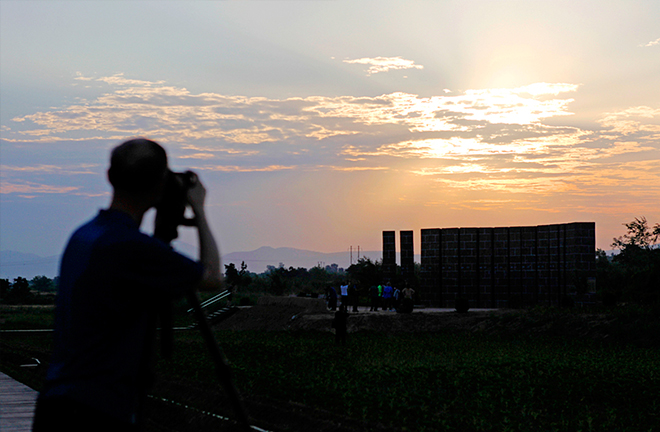Academics decipher early China from Taosi culture

A photographer takes pictures of the sunrise during Summer Solstice near the observatory of the Taosi site on June 21. Photo: CFP
TAIYUAN—The Taosi ruins (c. 2300–1900 BCE) in Xiangfen County, Shanxi Province, located in the middle reaches of the Yellow River and the Jinnan Basin, is an important site for China’s national research project on tracing the origins of Chinese civilization. After 40-odd years of excavations and research, scholars have continuously cracked the civilizational code of “China in earliest times” from Taosi culture, deepening their understanding of the origins of the civilization.
From July 20 to 22, a symposium on “The Origins of Chinese Civilization: The Case of Taosi” was held in Taiyuan, Shanxi Province. Participants discussed in depth the origins of Chinese civilization in the case of Taosi from such perspectives as archaeology, historical philology, and astronomy.
What civilizational form did China take in its earliest times, and how was it shaped? People traced back to Yao, Shun, and Yu [sage-rulers of antiquity in China] and the following Xia (c. 21st–16th century BCE), Shang (c. 16th–11th century BCE), and Zhou (c. 1046–256 BCE) dynasties to find answers, but records and documents on ancient Chinese history were veiled in mystery.
Starting from 1978, archaeologists have been excavating and studying the Taosi ruins. Since the site was included in the national research project on tracing the origins of Chinese civilization in 2002, an urban settlement, a palace enclosure, and a storage zone from the Early Taosi period (c. 2300–2100 BCE), and large cemeteries in walled-towns and an observatory-altar from the Middle Taosi period (c. 2100–2000 BCE) have been excavated one after another. This capital site, which dates to 4,300–4,000 years ago with an expanding scale, has helped academics reveal the cultural core of China in its earliest times.
“After more than four decades of archaeological excavations and research of the Taosi site, we have initially established a relatively complete set of archaeological-philological-anthropological evidence chains, indicating that Taosi was the capital under the reigns of Yao and Shun,” said He Nu, a research fellow from the Institute of Archaeology at the Chinese Academy of Social Sciences (CASS).
He Nu noted that the mark on Section 11 on the gnomon shadow template unearthed from the monarchic mausoleum IIM22 from the Middle period, the nature of the capital city site of Taosi, and the national and social attributes of the Taosi culture mark the initial formation of the concept of Zhong Guo (literally the Central State, Chinese name for China) in Taosi. They also showcase the political culture of jing tian wei di, having heaven and earth under control, often interpreted as state governance, in the Yao and Shun periods.
According to the “Canon of Yao” part of the ancient Chinese classic Book of Documents, calculating and delineating (the movements and appearances of) the sun, the moon, the stars, and the zodiacal spaces, to deliver the seasons to be observed by the people, was considered significant to state governance during the rule of Yao.
Zhou Xiaolu, a professor from the School of History at Nanjing University, said that at the stage when the concepts of class and state took shape in China, out of the need for stable agricultural production, national-level time-reporting stations or institutions like observatories were built to provide fairly complete astronomical support for observing celestial phenomena and developing the calendar. Prehistoric China should have mastered the law of time that one year consists of 365 days plus a quarter of one day, Zhou conjectured.
This conjecture has been confirmed by the prehistoric astronomical observation devices discovered at the Taosi site by the Shanxi Archaeological Team from CASS’s Institute of Archaeology led by He Nu.
According to Li Geng, an associate research fellow from the National Astronomical Observatories at the Chinese Academy of Sciences, the method of gnomon shadow measurement can realize large-scale geographical distance measurement, laying a technical foundation for the emergence of the ancient enfeoffment system.
Serving the kingship and social politics through precise management of time and space was an important part of the political and institutional culture in the state at Taosi.
“Jing tian wei di is the core gene of the Taosi state’s time-space political culture, which marks the beginning of time and space management in Chinese civilization’s political and institutional culture, and was inherited and improved in subsequent dynasties,” He Nu said.
Kingship-based state and society of rites are the main features of ancient Chinese civilization with the civilization created by the Huaxia (Han) ethnic group as the main body. Gao Jiangtao, a research fellow from CASS’s Institute of Archaeology, pointed out that the Taosi culture combines the characteristics of a royal state and a ritual society, and is the chief vein of the Huaxia civilization.
In addition, the Taosi culture is also an example of civilizational integration. According to Li Xinwei, a research fellow from CASS’s Institute of Archaeology, although the Taosi site and the Liangzhu site are located in the Greater Central Plains of north China and in the southeast region, respectively, the two major civilizations were by no means only continuing in their own local traditions—rather, they presented features of integrated development, which is typical of Chinese civilization. Different regional civilizations developed diversely in a broad space, collided with each other, and formed a cultural community, Li said.
The symposium was hosted by Shanxi Cultural Relics Bureau and CASS’s Institute of Archaeology, and organized by the Shanxi Provincial Institute of Archaeology and the Shanxi Archaeology Team from CASS.
Edited by CHEN MIRONG

 PRINT
PRINT CLOSE
CLOSE